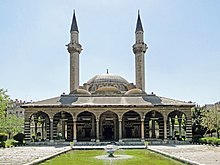| Sulaymaniyya Takiyya التَّكِيَّة السُّلَيْمَانِيَّة | |
|---|---|
 View of the mosque from its courtyard | |
| Religion | |
| Affiliation | Islam |
| Region | Levant |
| Status | Active |
| Location | |
| Location | Damascus, Syria |
| Geographic coordinates | 33°30′45″N 36°17′29″E / 33.51250°N 36.29139°E |
| Architecture | |
| Architect(s) | Mimar Sinan |
| Type | takiyya (mosque complex) |
| Style | Ottoman architecture |
| Completed | 1554–1558/59 (western building: mosque and imaret) 1566–67 (eastern building: Salimiyya Madrasa) |
| Specifications | |
| Minaret(s) | 2 |
| Materials | Stone, marble, mosaic |
The Sulaymaniyya Takiyya (Arabic: التَّكِيَّة السُّلَيْمَانِيَّة, romanized: at-Takiyya as-Sulaymāniyya; Turkish: Şam Süleymaniye Külliyesi[1]) is a takiyya (Ottoman-era Arabic name for a mosque complex which served as a Sufi convent) in Damascus, Syria, located on the right bank of the Barada River.[2] Commissioned by the Ottoman sultan Suleiman the Magnificent, the western building of the complex was built, following the plans of Mimar Sinan, between 1554 and 1559. Another building was added eastwards from it in 1566 to be used as a madrasa (which became known as the Salimiyya Madrasa, named after Suleiman's son Selim II, although this building too may have been commissioned by Suleiman before his death).
Although not the first Ottoman building in Damascus (that is considered to have been the Salimiyya Takiyya in as-Salihiyya[3]), the Sulaymaniyya Takiyya is considered to have marked the introduction of the Ottoman architectural style to Damascus.[4] In the centuries following its construction, the Sulaymaniyya Takiyya became an important stop on the "Syrian route" of pilgrims to Mecca, and it is considered to this day "as the most important Ottoman cultural building" in Damascus.[5]
In the cemetery of the complex, the last Ottoman sultan is buried, Mehmed VI, who was forced into exile upon the abolition of the Ottoman sultanate in 1922.[6][7]
- ^ Şam Süleymaniye Külliyesi ve Koruma Sorunları (PDF) (in Turkish). 2009.
- ^ "Takiyya Sulaymaniyya, Damascus, Syria". Archnet Digital Library. Retrieved 20 March 2017..
- ^ Abd al-Qadir al-Rihawi; Émilie E. Ouéchek (1975). "Les deux takiyya de Damas". Bulletin d'études orientales. Vol. 28. Institut Francais du Proche-Orient. pp. 217–225. JSTOR 41604595.
- ^ Gérard Degeorge (1994). Damas. p. 46.
- ^ Tammam Taher Bakeer (2009). Collapse Analysis of Masonry Structures Under Earthquake Action.
- ^ Raşit GÜNDOĞDU; Büşra YILDIZ (2020). The Sultans of the Ottoman Empire. Rumuz Yayınları. p. 247. ISBN 978-605-5112-15-8.
His funeral was brought to Beirut and later to Damascus and buried in the cemetery in the garden of Süleymaniye Complex.
- ^ Freely, John, Inside the Seraglio, published 1999, Chapter 19: The Gathering Place of the Jinns